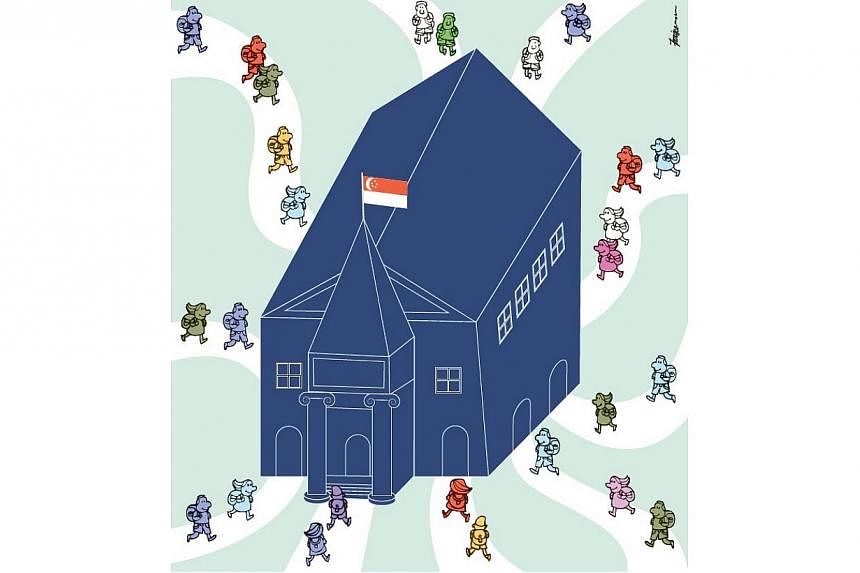PHASE 2C, the most competitive part of the Primary 1 school registration exercise, ended yesterday with 86 oversubscribed primary schools having to conduct a ballot to allocate places. Last year, 91 schools had to ballot for places under Phase 2C.
The slight drop has been attributed to the change in rules for Primary 1 registration this year but further analysis of the figures shows that this may not be the case. It is more likely due to the fluctuations in demand from year to year.
The rule change sets aside 20 places for pupils in Phase 2B for parent volunteers and those with church and clan connections and another 20 for Phase 2C, which applies to parents with no connections to the school.
Together, the 40 places are meant to ensure even top schools have places for those with no alumni connections to the school. Earlier phases are for children whose parents or siblings are former pupils.
The rule setting aside 20 places each in Phases 2B and 2C is meant to halt a trend in which popular schools were becoming "closed circles" for a select few.
Even Prime Minister Lee Hsien Loong has acknowledged the problem. Referring to Henry Park Primary School last year, where fewer than 10 places were left for those without connections, he said: "If we do nothing, one day, these schools may have no places at all for those with no connections. We don't want our primary schools to become closed institutions, and you can only get in if your parents had been there."
Many parents think that the Ministry of Education (MOE) should go further and that the current rule should be inverted: Only 40 places should be set aside for those with alumni connections to the school. The rest should be left open.
They may have a point.
Let's take Henry Park, for example. This year, for Phase 2C, only 22 places were left and 50 parents registered. The school held a ballot yesterday to give out the remaining places.
Last year, eight places were left for Phase 2C. That means that despite the rule change, only 14 more places went to those without any connections to the school this year.
If you were to study the figures for Phases 2A(1) and 2A(2) - the phases that apply to alumni - then more than 100 places at several popular schools, including Henry Park, Anglo-Chinese School (Primary) and Ai Tong, went to alumni.
We have to ask ourselves: Should so many places go to the alumni? Is this a healthy trend? Especially when we are trying to change the student mix in top schools to include children from different races and socio-economic backgrounds.
The situation would be very different if only 40 places were allocated to the phases covering alumni, volunteers and those with clan or church links.
This would free up more places - at least 100 - for those without connections and foster a student mix that is more diverse.
Of course, there is the argument that former pupils and parent volunteers help build up and strengthen the schools' traditions and ethos.
But it is well-known, and clan officials confirm it, that many parents who take up membership just before the registration are hardly ever seen again.
Of course, whatever new rule is set, parents will try and find a way around it. In fact, this year many alumni parents moved nearer the schools of their choice to hedge their bets. If the number of applications exceeds places in any of the phases for Primary 1 registration, those living near the school will have priority.
So you can expect that if the scheme is changed to allow more places for Phase 2C, then many more parents will buy or rent residences near the schools of their choice.
Many popular schools are located in Bukit Timah, which has scant public housing and where property prices are among the highest. Basing admission criteria on distance therefore ends up privileging the rich.
But as many have argued before, the problem can be overcome if some of these schools are relocated to neighbourhoods which have a mix of different housing types.
The MOE can perhaps reveal the population mix of schools like Rosyth, which stands in Serangoon North Avenue 4, in the middle of three- to five-room flats.
Has locating Rosyth in an HDB estate led to a more diverse student population than the likes of Nanyang Primary or the Anglo-Chinese Primary schools?
And how about moving the lesser-known neighbourhood schools to Bukit Timah? They may flourish with the support of the community around them and become "good schools" over the years.
Lack of diversity in schools is a serious problem. As sociologists have warned, it perpetuates advantages from one generation to the next and serves to heighten social inequality. In elite schools, peers form exclusive circles, share resources and hoard opportunities.
The networks they form yield benefits beyond graduation - to land the right job, for one thing.
A more serious outcome of all this is that students grow up not understanding the plight of the poor or disadvantaged. A social worker friend recently recounted how a group of students from a top school complained of how HDB rental flats "are an assault on their olfactory senses".
Changing the criteria to lessen the advantage for parents with school connections will no doubt incur their ire.
But it is necessary if we want to rebalance the poor student-population mix quite evident in the popular schools.
The move this year to reserve 40 places is a good first step. But to really have a more diverse mix, MOE should look into relocating top schools out of the Bukit Timah belt and spreading them out across Singapore.


